Sea Surface Salinity Variability in the Bering Sea in 2015–2020
Abstract
:1. Introduction
2. Materials and Methods
2.1. In Situ Gridded Data
2.2. In Situ Saildrone Measurements
2.3. Satellite SSS Products
2.4. Surface Wind
3. Results
3.1. SSS in Gridded Datasets
3.1.1. Mean SSS Fields
3.1.2. Annual Cycle
3.2. SSS during Saildrone Missions
3.2.1. Saildrone Missions in 2015
3.2.2. Saildrone Missions in 2016
3.2.3. Saildrone Missions in 2017
4. Discussion and Conclusions
Author Contributions
Funding
Data Availability Statement
Acknowledgments
Conflicts of Interest
References
- Stabeno, P.J.; Schumacher, J.D.; Ohtani, K. The physical oceanography of the Bering Sea. In Dynamics of the Bering Sea: A Summary of Physical, Chemical, and Biological Characteristics, and a Synopsis of Research on the Bering Sea, North Pacific Marine Science Organization (PICES); Loughlin, T.R., Ohtani, K., Eds.; University of Alaska Sea Grant: Fairbanks, AK, USA, 1999; pp. 1–28. [Google Scholar]
- Hunt, G.L., Jr.; Stabeno, P.J.; Walters, G.; Sinclair, E.; Brodeur, R.D.; Napp, J.M.; Bond, N.A. Climate change and control of the southeastern Bering Sea pelagic ecosystem. Deep. Sea Res. II 2002, 49, 5821–5853. [Google Scholar] [CrossRef] [Green Version]
- Hunt, G.L., Jr.; Stabeno, P.J. Climate change and the control of energy flow in the southeastern Bering Sea. Prog. Oceanogr. 2002, 55, 5–22. [Google Scholar] [CrossRef] [Green Version]
- Aagaard, K.; Weingartner, T.J.; Danielson, S.L.; Woodgate, R.A.; Johnson, G.C.; Whitledge, T.E. Some controls on flow and salinity in Bering Strait. Geophys. Res. Lett. 2006, 33. [Google Scholar] [CrossRef]
- Danielson, S.L.; Weingartner, T.J.; Hedstrom, K.S.; Aagaard, K.; Woodgate, R.; Curchitser, E.; Stabeno, P.J. Coupled wind-forced controls of the Bering-Chukchi Shelf circulation and the Bering Strait throughflow: Ekman transport, continental shelf waves, and variations of the Pacific-Arctic sea surface height gradient. Prog. Oceanogr. 2014, 125, 40–61. [Google Scholar] [CrossRef] [Green Version]
- Woodgate, R.A.; Peralta-Ferriz, C. Warming and Freshening of the Pacific Inflow to the Arctic From 1990–2019 Implying Dramatic Shoaling in Pacific Winter Water Ventilation of the Arctic Water Column. Geophys Res Lett. 2021, 48, e2021GL092528. [Google Scholar] [CrossRef]
- Overland, J.E.; Salo, S.A.; Kantha, L.H.; Clayson, C.A. Thermal stratification and mixing on the Bering Sea shelf. In Dynamics of the Bering Sea: A summary of physical, chemical, and biological characteristics, and a synopsis of research on the Bering Sea; Loughlin, T.R., Ohtani, K., Eds.; University of Alaska Sea Grant: Fairbanks, AK, USA, 1999; pp. 129–146. [Google Scholar]
- Cokelet, E.D. 3-D water properties and geostrophic circulation on the eastern Bering Sea shelf. Deep Sea Res. Part II Top. Stud. Oceanogr. 2016, 134, 65–85. [Google Scholar] [CrossRef] [Green Version]
- Mysak, L.A.; Manak, D.K. Arctic sea-ice extent and anomalies, 1953–1984. Atmos. Ocean. 1989, 27, 376–405. [Google Scholar] [CrossRef]
- Francis, J.A.; Hunter, E. Drivers of declining sea ice in the Arctic winter: A tale of two seas. Geophys. Res. Lett. 2007, 34, 1–5. [Google Scholar] [CrossRef] [Green Version]
- Zhang, J.L.; Woodgate, R.; Moritz, R. Sea ice response to atmospheric and oceanic forcing in the Bering Sea. J. Phys. Oceanogr. 2010, 40, 1729–1747. [Google Scholar] [CrossRef]
- Stabeno, P.J.; Bell, S.W. Extreme Conditions in the Bering Sea (2017–2018): Record-Breaking Low Sea-Ice Extent. Geophys. Res. Lett. 2019, 46, 8952–8959. [Google Scholar] [CrossRef]
- Danielson, S.; Weingartner, T.; Aagaard, K.; Zhang, J.; Woodgate, R. Circulation on the central Bering Sea shelf, July 2008 to July 2010. J. Geophys. Res. 2012, 117, C10003. [Google Scholar] [CrossRef] [Green Version]
- Kachel, N.B.; Hunt, G.L., Jr.; Salo, S.A.; Schumacher, J.D.; Stabeno, P.J.; Whitledge, T.E. Characteristics and variability of the inner front of the southeastern Bering Sea. Deep Sea Res. Part II Top. Stud. Oceanogr. 2002, 49, 5889–5909. [Google Scholar] [CrossRef] [Green Version]
- Dean, K.G.; McRoy, C.P.; Ahlnas, K.; Springer, A. The plume of the Yukon River in relation to the oceanography of the Bering Sea. Remote Sens. Environ. 1989, 28, 75–84. [Google Scholar] [CrossRef]
- Cokelet, E.D.; Meinig, C.; Lawrence-Slavas, N.; Stabeno, P.J.; Mordy, C.W.; Tabisola, H.M.; Jenkins, R.; Cross, J.N. The use of Saildrones to examine spring conditions in the Bering Sea. In Proceedings of the OCEANS’15 MTS/IEEE Washington, Washington, DC, USA, 19–22 October 2015. [Google Scholar]
- Danielson, S.; Eisner, L.; Weingartner, T.; Aagaard, K. Thermal and haline variability over the central Bering Sea shelf: Seasonal and inter-annual perspectives. Cont. Shelf Res. 2011, 31, 539–554. [Google Scholar] [CrossRef]
- Chikita, K.A.; Wada, T.; Kudo, I.; Saitoh, S.-I.; Hirawake, T.; Toratani, M. Behaviors of the Yukon River Sediment Plume in the Bering Sea: Relations to Glacier-Melt Discharge and Sediment Load. Water 2021, 13, 2646. [Google Scholar] [CrossRef]
- Ladd, C.; Stabeno, P.J. Stratification on the Eastern Bering Sea shelf revisited. Deep Sea Res. II 2012, 65, 72–83. [Google Scholar] [CrossRef]
- Stabeno, P.J.; Schumacher, D.J.; Davis, F.R.; Napp, M.J. Under-ice observations of water column temperature, salinity and spring phytoplankton dynamics: Eastern Bering Sea shelf. J. Mar. Res. 1998, 56, 239–255. [Google Scholar] [CrossRef]
- Sullivan, M.; Kachel, N.B.; Mordy, C.W.; Salo, S.A.; Stabeno, P.J. Sea ice and water column structure on the eastern Bering Sea shelf. Deep Sea Res. Part II Top. Stud. Oceanogr. 2014, 109, 39–56. [Google Scholar] [CrossRef]
- Andreas, E.L.; Horst, T.; Grachev, A.; Persson, P.; Fairall, C.; Guest, P.; Jordan, R. Parametrizing turbulent exchange over summer sea ice and the marginal ice zone. Quart. J. Roy. Meteor. Soc. 2010, 136, 927–943. [Google Scholar] [CrossRef] [Green Version]
- Randelhoff, A.; Fer, I.; Sundfjord, A. Turbulent upper-ocean mixing affected by meltwater layers during Arctic summer. J. Phys. Oceanogr. 2017, 47, 835–853. [Google Scholar] [CrossRef] [Green Version]
- Vinogradova, N.; Lee, T.; Boutin, J.; Drushka, K.; Fournier, S.; Sabia, R.; Stammer, D.; Bayler, E.; Reul, N.; Gordon, A.; et al. Satellite salinity observing system: Recent discoveries and the way forward. Front. Mar. Sci. 2019, 6, 243. [Google Scholar] [CrossRef]
- Yu, L.; Bingham, F.M.; Lee, T.; Dinnat, E.P.; Fournier, S.; Melnichenko, O.; Tang, W.; Yueh, S.H. Revisiting the Global Patterns of Seasonal Cycle in Sea Surface Salinity. J. Geophys. Res. Ocean. 2021, 126, e2020JC016789. [Google Scholar] [CrossRef]
- Köhler, J.; Martins, M.S.; Serra, N.; Stammer, D. Quality assessment of spaceborne sea surface salinity observations over the northern North Atlantic. J. Geophys. Res. Oceans 2015, 120, 94–112. [Google Scholar] [CrossRef] [Green Version]
- Garcia-Eidell, C.; Comiso, J.C.; Dinnat, E.; Brucker, L. Satellite observed salinity distributions at high latitudes in the Northern Hemisphere: A comparison of four products. J. Geophys. Res. Ocean 2017, 122, 7717–7736. [Google Scholar] [CrossRef] [PubMed] [Green Version]
- Tang, W.; Yueh, S.; Yang, D.; Fore, A.; Hayashi, A.; Lee, T.; Fournier, S.; Holt, B. The potential and challenges of using SMAP SSS to monitor Arctic Ocean freshwater changes. Remote Sens. 2018, 10, 869. [Google Scholar] [CrossRef] [Green Version]
- UNESCO. The Practical Salinity Scale 1978 and the International Equation of State of Sea water 1980. UNESCO Tech. Pap. Mar. Sci. 1981, 25, 68. [Google Scholar]
- Olmedo, E.; Gabarró, C.; González-Gambau, V.; Martínez, J.; Ballabrera-Poy, J.; Turiel, A.; Portabella, M.; Fournier, S.; Lee, T. Seven years of SMOS sea surface salinity at high latitudes: Variability in Arctic and Sub-Arctic regions. Remote Sens. 2018, 10, 1772. [Google Scholar] [CrossRef] [Green Version]
- Reul, N.; Grodsky, S.A.; Arias, M.; Boutin, J.; Catany, R.; Chapron, B.; D’Amico, F.; Dinnat, E.; Donlon, C.; Fore, A.; et al. Sea surface salinity estimates from spaceborne L-band radiometers: An overview of the first decade of observation (2010–2019). Remote Sens. Environ. 2020, 242, 111769. [Google Scholar] [CrossRef]
- Fournier, S.; Lee, T.; Tang, W.; Steele, M.; Olmedo, E. Evaluation and Intercomparison of SMOS, Aquarius, and SMAP Sea Surface Salinity Products in the Arctic Ocean. Remote Sens. 2019, 11, 3043. [Google Scholar] [CrossRef] [Green Version]
- Fournier, S.; Lee, T.; Wang, X.; Armitage, T.W.K.; Wang, O.; Fukumori, I.; Kwok, R. Sea surface salinity as a proxy for Arctic Ocean freshwater changes. J. Geophys. Res. Ocean. 2020, 125, e2020JC016110. [Google Scholar] [CrossRef]
- Kubryakov, A.; Stanichny, S.; Zatsepin, A. River plume dynamics in the Kara Sea from altimetry-based lagrangian model, satellite salinity and chlorophyll data. Remote Sens. Environ. 2016, 176, 177–187. [Google Scholar] [CrossRef]
- Matsuoka, A.; Babin, M.; Devred, E.C. A new algorithm for discriminating water sources from space: A case study for the southern Beaufort Sea using MODIS ocean color and SMOS salinity data. Remote Sens. Environ. 2016, 184, 124–138. [Google Scholar] [CrossRef]
- Supply, A.; Boutin, J.; Vergely, J.-L.; Kolodziejczyk, N.; Reverdin, G.; Reul, N.; Tarasenko, A. New insights into SMOS sea surface salinity retrievals in the Arctic Ocean. Remote Sens. Environ. 2020, 249, 112027. [Google Scholar] [CrossRef]
- Chiodi, A.M.; Zhang, C.; Cokelet, E.D.; Yang, Q.; Mordy, C.W.; Gentemann, C.L.; Cross, J.N.; Lawrence-Slavas, N.; Meinig, C.; Steele, M.; et al. Exploring the Pacific Arctic Seasonal Ice Zone with Saildrone USVs. Front. Mar. Sci. 2021, 8, 640690. [Google Scholar] [CrossRef]
- Levine, R.M.; de Robertis, A.; Grünbaum, D.; Woodgate, R.; Mordy, C.W.; Mueter, F.; Cokelet, E.; Lawrence-Slavas, N.; Tabisola, H. Autonomous vehicle surveys indicate that flow reversals retain juvenile fishes in a highly advective high-latitude ecosystem. Limnol. Oceanogr. 2021, 66, 1139–1154. [Google Scholar] [CrossRef]
- Vazquez-Cuervo, J.; Gentemann, C.; Tang, W.; Carroll, D.; Zhang, H.; Menemenlis, D.; Gomez-Valdes, J.; Bouali, M.; Steele, M. Using Saildrones to Validate Arctic Sea-Surface Salinity from the SMAP Satellite and from Ocean Models. Remote Sens. 2021, 13, 831. [Google Scholar] [CrossRef]
- Meinig, C.; Lawrence-Slavas, N.; Jenkins, R.; Tabisola, H.M. The use of Saildrones to examine spring conditions in the Bering Sea: Vehicle specification and mission performance. In Proceedings of the OCEANS 2015-MTS/IEEE Washington, Washington, DC, USA, 19–22 October 2015. [Google Scholar]
- Mordy, C.W.; Cokelet, E.D.; De Robertis, A.; Jenkins, R.; Kuhn, C.E.; Lawrence-Slavas, N.; Berchok, C.L.; Crance, J.L.; Sterling, J.T.; Cross, J.N.; et al. Advances in Ecosystem Research Saildrone Surveys of Oceanography, Fish, and Marine Mammals in the Bering Sea. Oceanography 2017, 30, 113–115. [Google Scholar] [CrossRef]
- Cabanes, C.; Grouazel, A.; von Schuckmann, K.; Hamon, M.; Turpin, V.; Coatanoan, C.; Paris, F.; Guinehut, S.; Boone, C.; Ferry, N.; et al. The CORA dataset: Validation and diagnostics of in-situ ocean temperature and salinity measurements. Ocean. Sci. 2013, 9, 1–18. [Google Scholar] [CrossRef] [Green Version]
- Szekely, T.; Gourrion, J.; Pouliquen, S.; Reverdin, G. The CORA 5.2 dataset for global in situ temperature and salinity measurements: Data description and validation. Ocean Sci. 2019, 15, 1601–1614. [Google Scholar] [CrossRef] [Green Version]
- Meissner, T.; Wentz, F.; Le Vine, D. The salinity retrieval algorithms for the NASA Aquarius version 5 and SMAP version 3 releases. Remote Sens. 2018, 10, 1121. [Google Scholar] [CrossRef] [Green Version]
- Boutin, J.; Vergely, J.L.; Khvorostyanov, D. SMOS SSS L3 Maps Generated by CATDS CEC LOCEAN Debias V5.0. Available online: https://www.seanoe.org/data/00417/52804/ (accessed on 8 September 2021).
- Melnichenko, O. Multi-Mission L4 Optimally Interpoated Sea Surface Salinity. Ver. 1.0. PO.DAAC, CA, USA. Available online: https://doi.org/10.5067/SMP10-4U7CS (accessed on 30 September 2021).
- Mesinger, F.; DiMego, G.; Kalnay, E.; Mitchell, K.; Shafran, P.C.; Ebisuzaki, W.; Jović, D.; Woollen, J.; Rogers, E.; Berbery, E.H.; et al. North American Regional Reanalysis. Bull. Am. Meteorol. Soc. 2006, 87, 343–360. [Google Scholar] [CrossRef] [Green Version]
- Danielson, S.; Hedstrom, K.; Aagaard, K.; Weingartner, T.; Curchitser, E. Wind-induced reorganization of the Bering shelf circulation. Geophys. Res. Lett. 2012, 39, L08601. [Google Scholar] [CrossRef]
- Alexander, V.; Niebauer, H.J. Oceanography of the eastern Bering Sea ice-edge zone in spring. Limnol. Oceanogr. 1981, 26, 1111–1125. [Google Scholar] [CrossRef]
- Wang, M.; Yang, Q.; Overland, J.E.; Stabeno, P.J. Sea-ice cover timing in the Pacific Arctic: The present and projections to mid-century by selected CMIP5 models. Deep. Sea Res. Part II Top. Stud. Oceanogr. 2018, 152, 22–34. [Google Scholar] [CrossRef] [Green Version]
- Fournier, S.; Lee, T. Seasonal and Interannual Variability of Sea Surface Salinity Near Major River Mouths of the World Ocean Inferred from Gridded Satellite and In-Situ Salinity Products. Remote Sens. 2021, 13, 728. [Google Scholar] [CrossRef]
- Melnichenko, O.; Hacker, P.; Maximenko, N.; Lagerloef, G.; Potemra, J. Optimal interpolation of Aquarius sea surface salinity. J. Geophys. Res. Oceans 2016, 121, 602–616. [Google Scholar] [CrossRef] [Green Version]
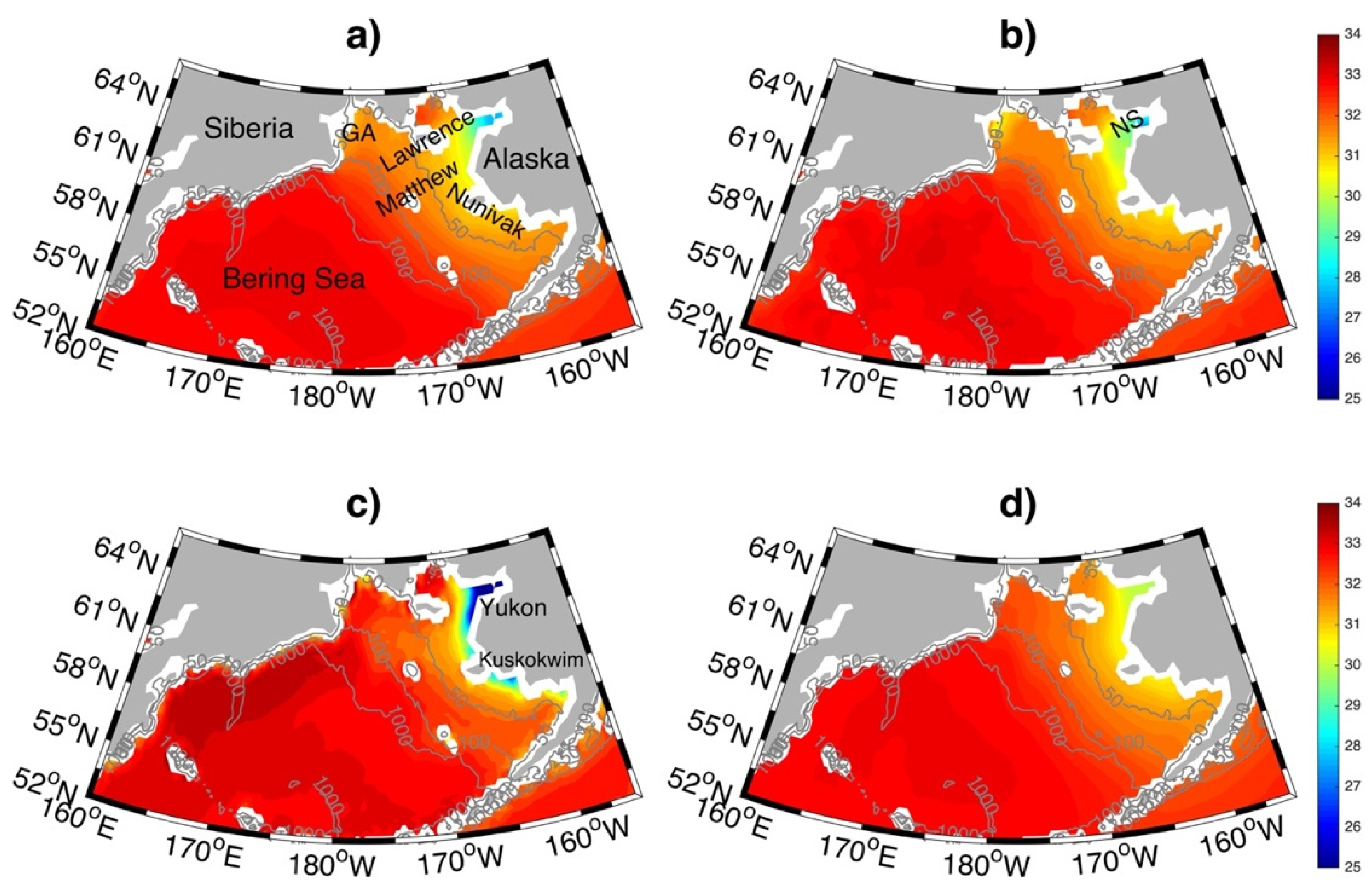
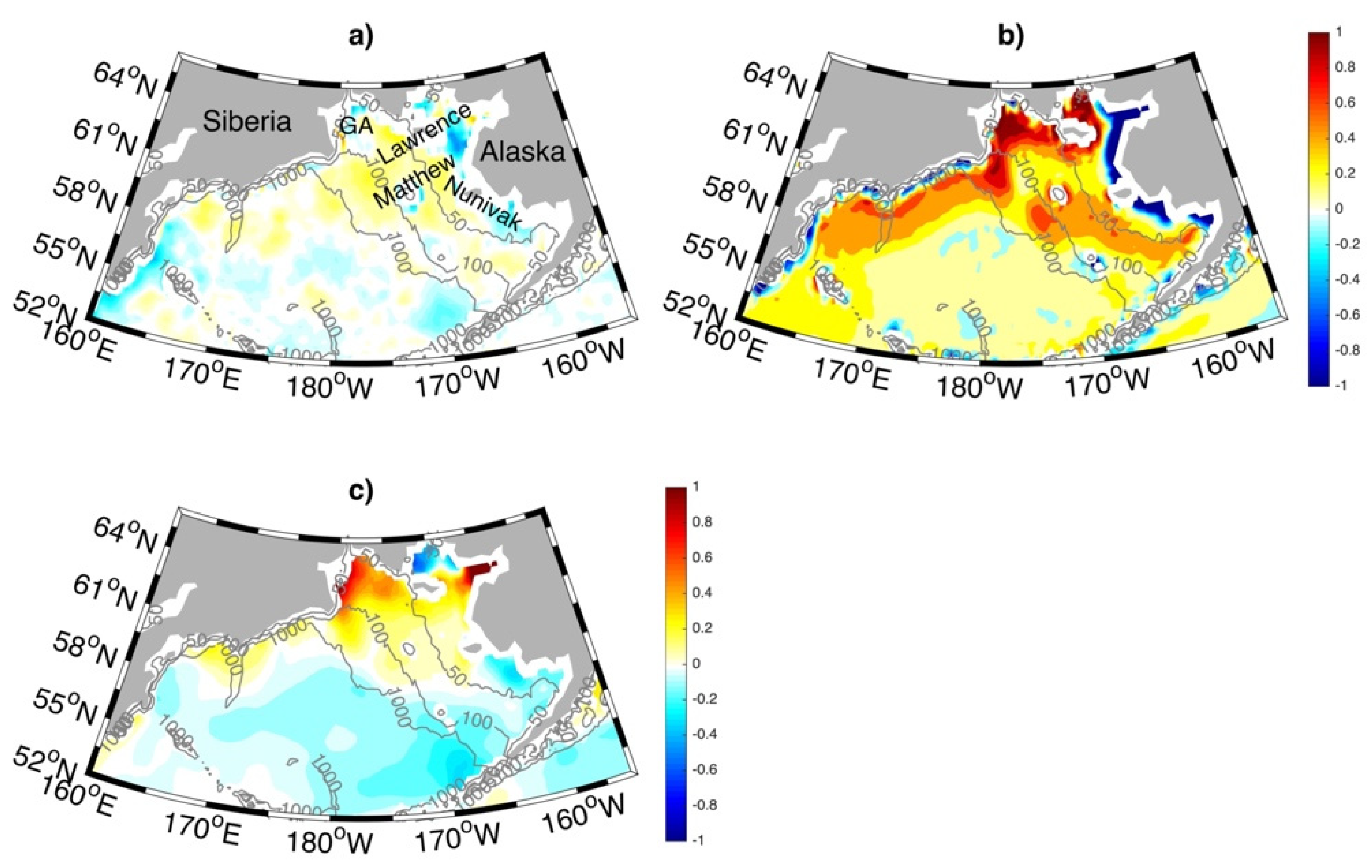

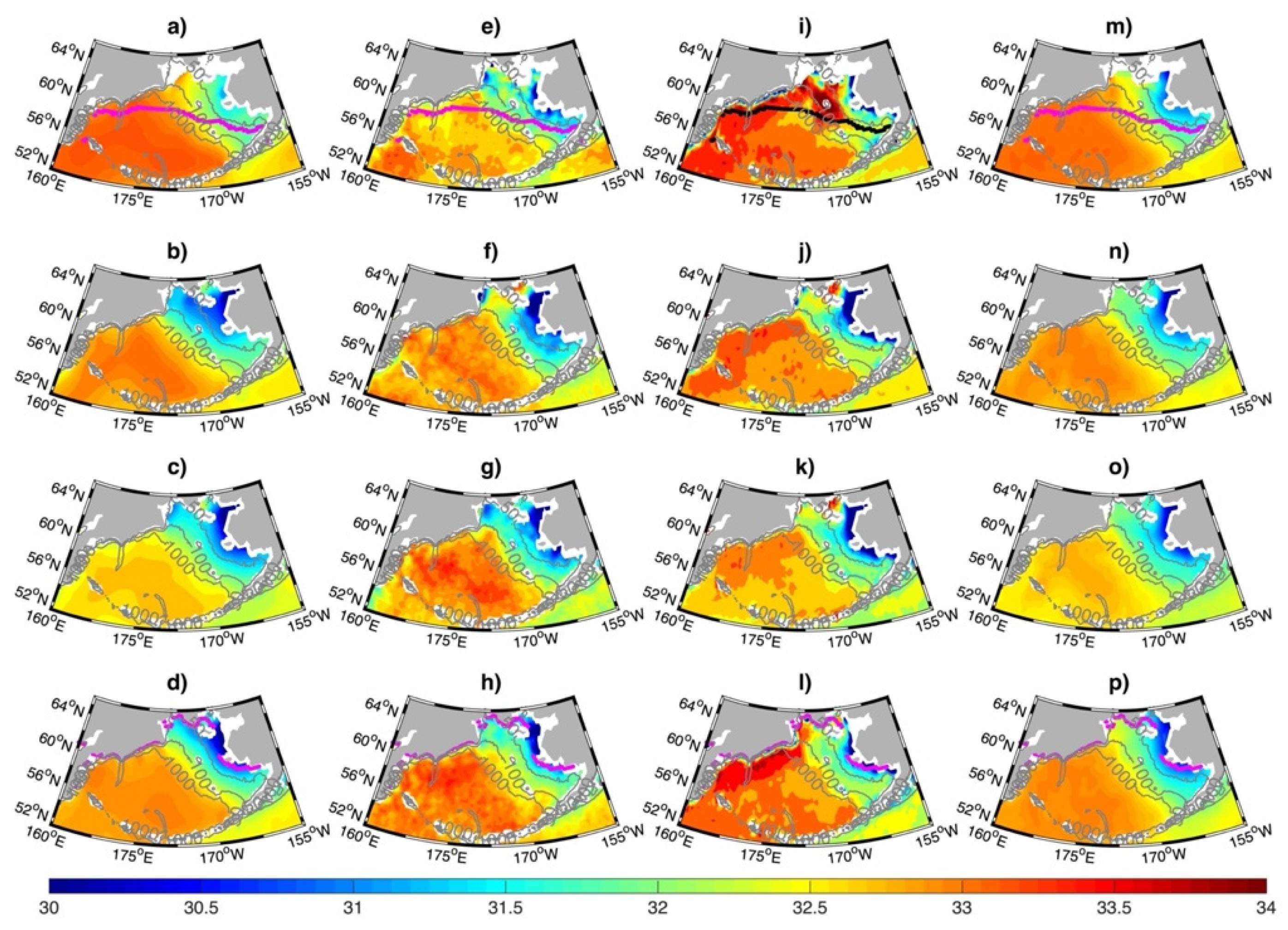
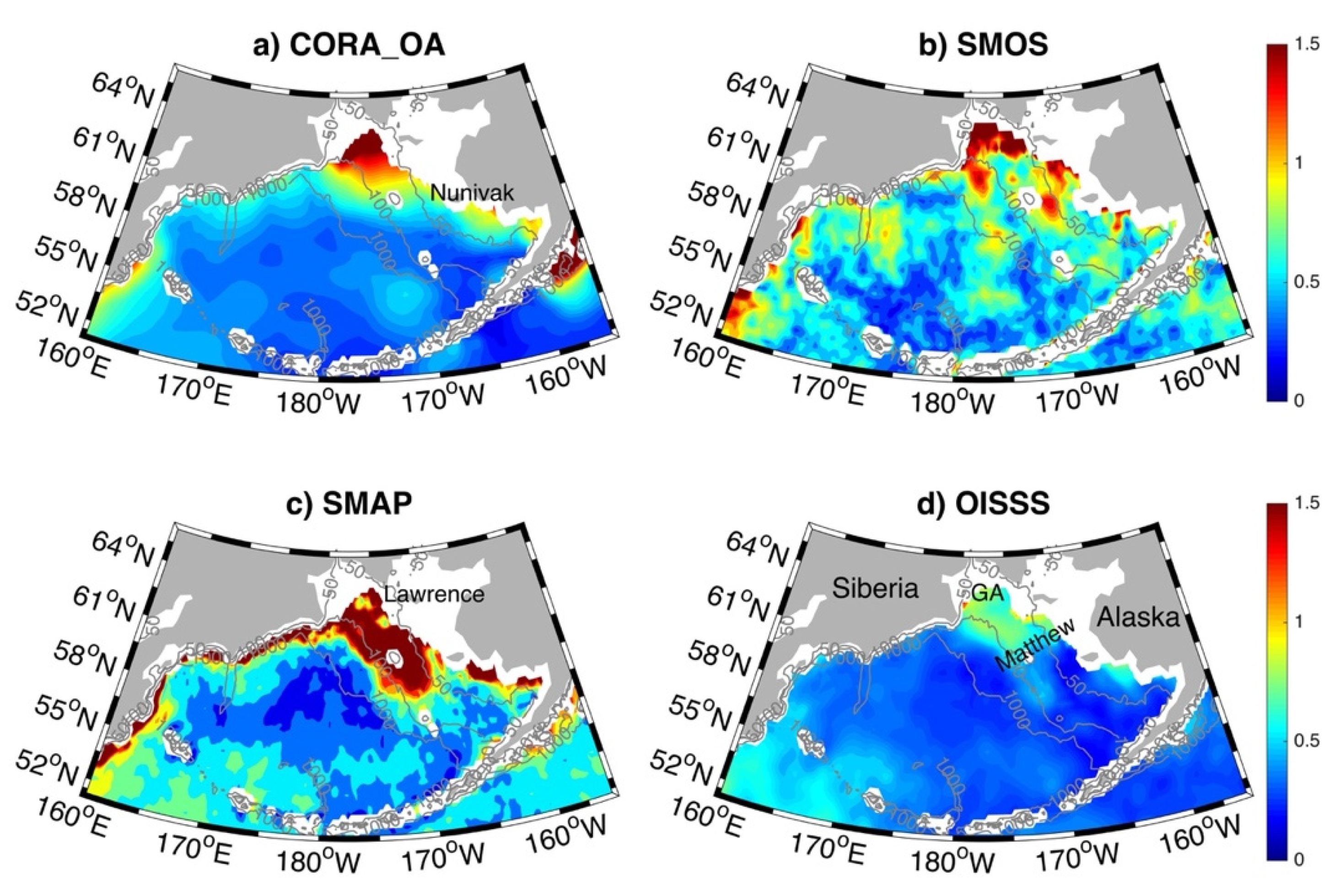
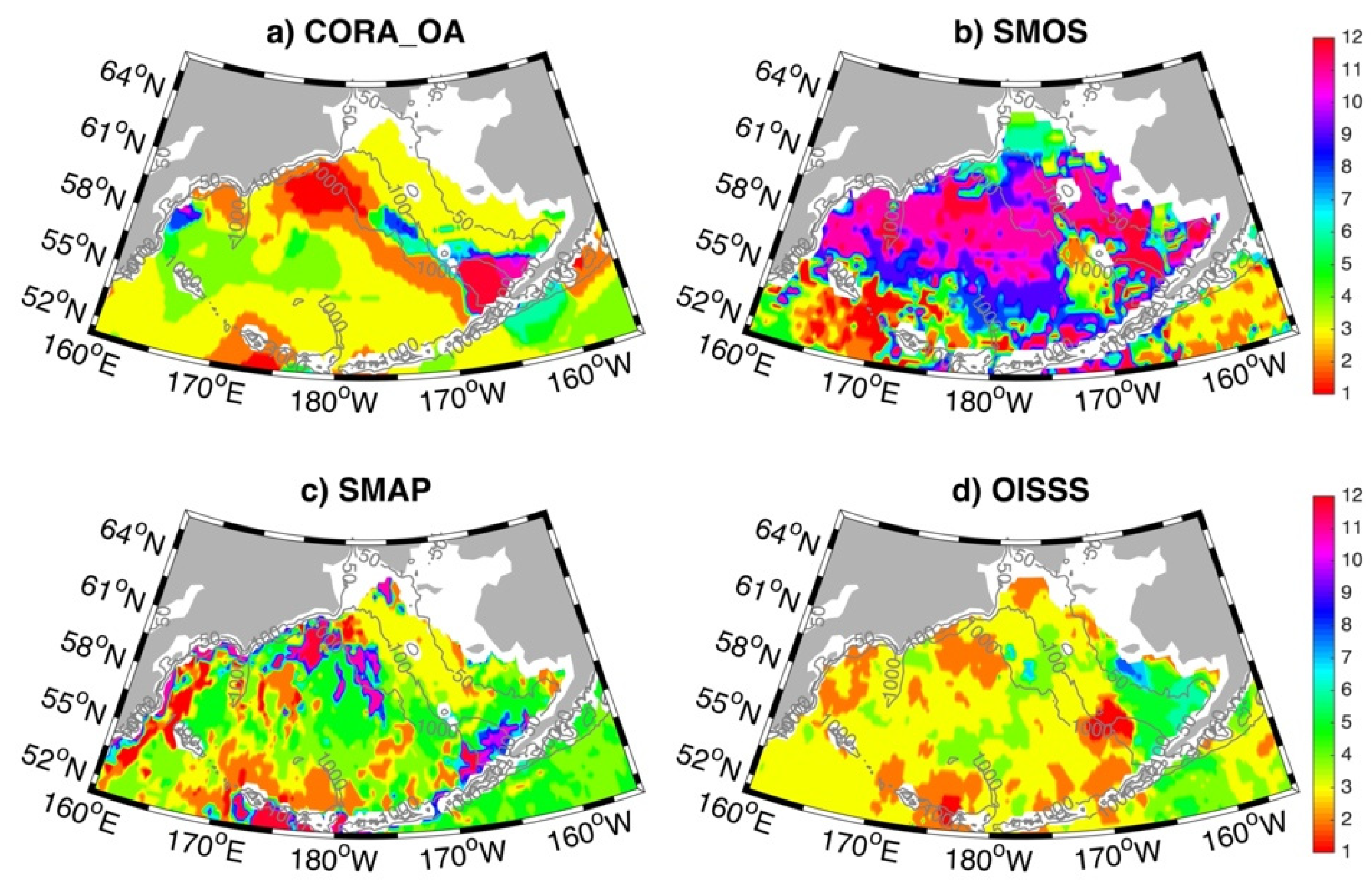
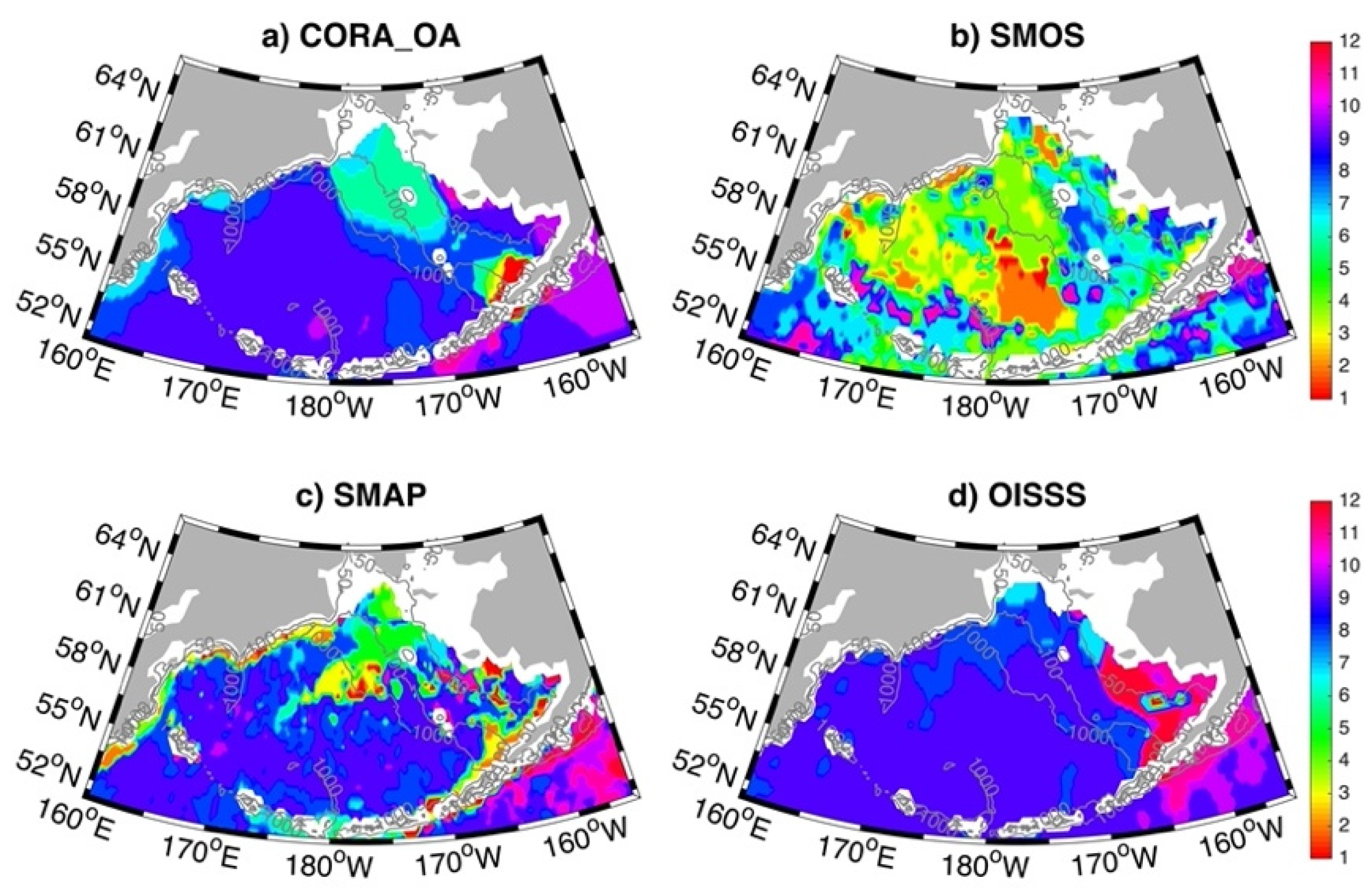

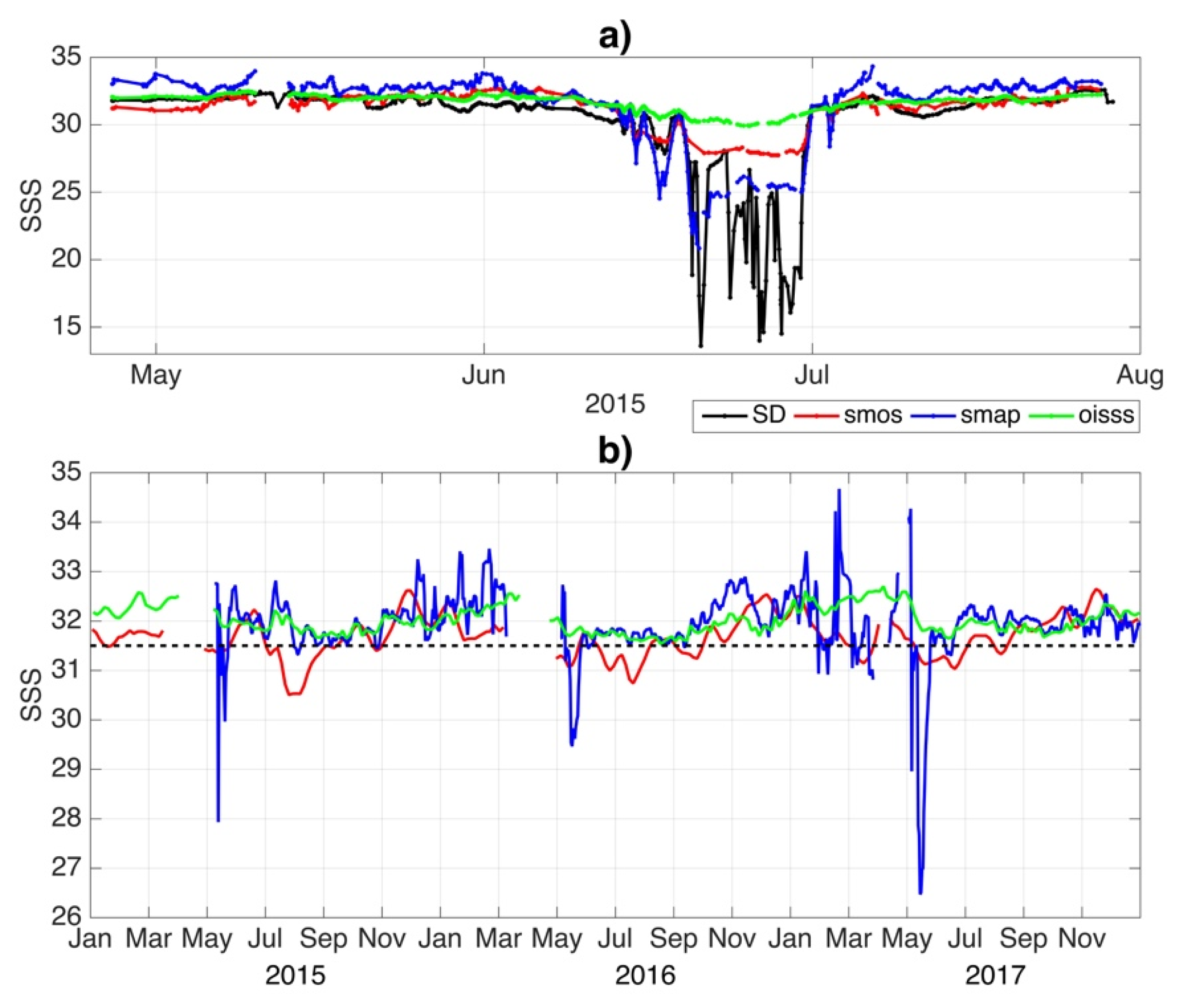
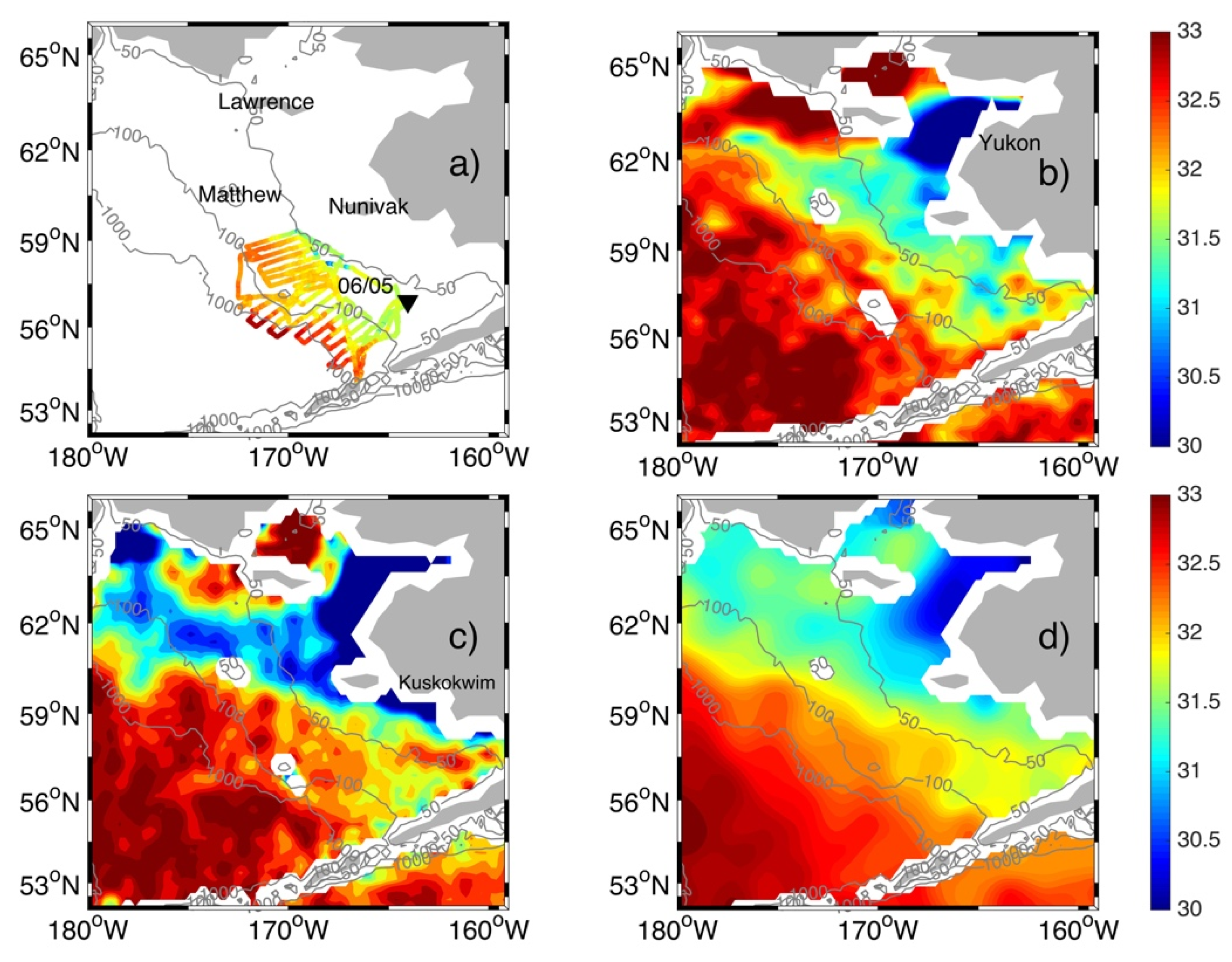
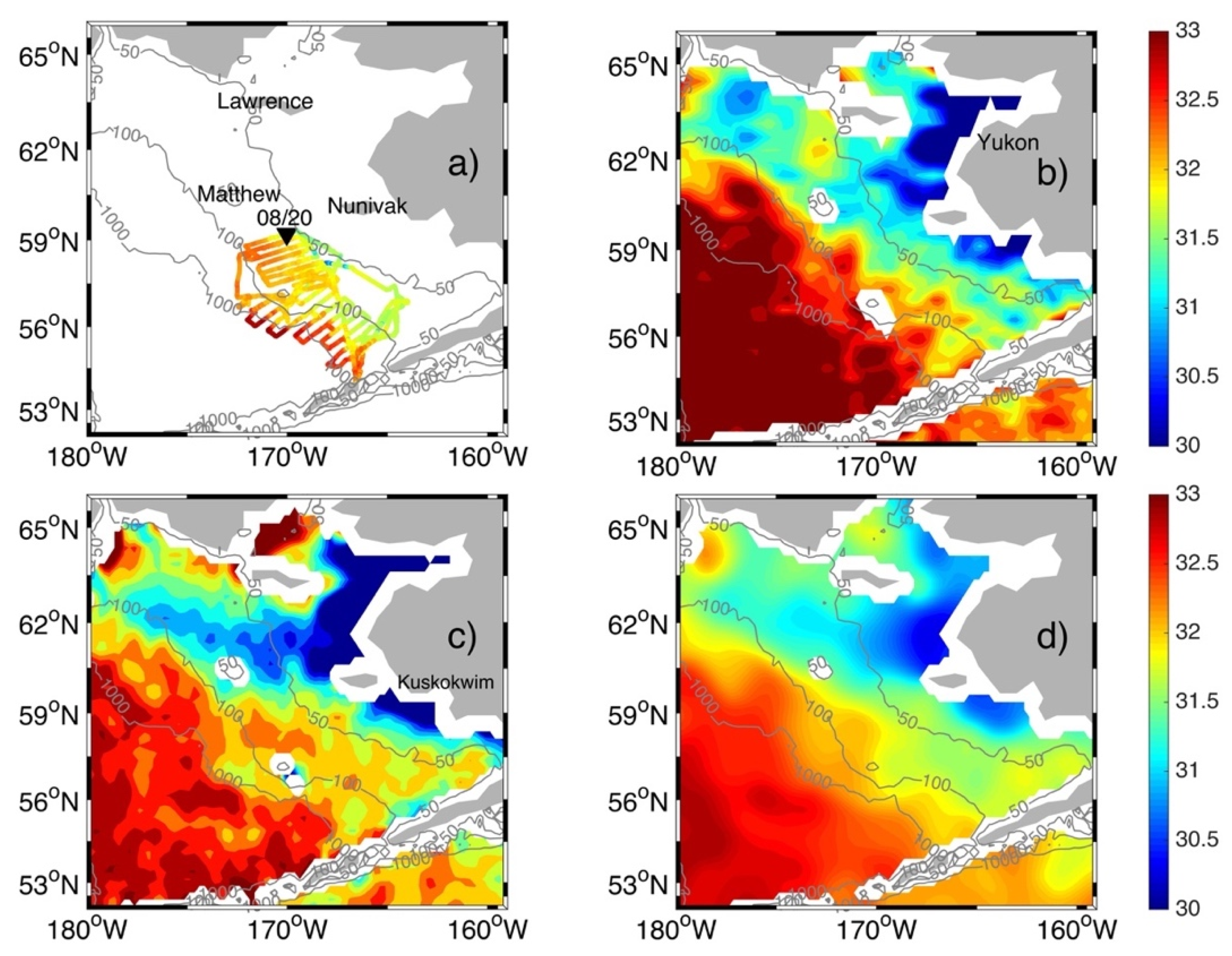
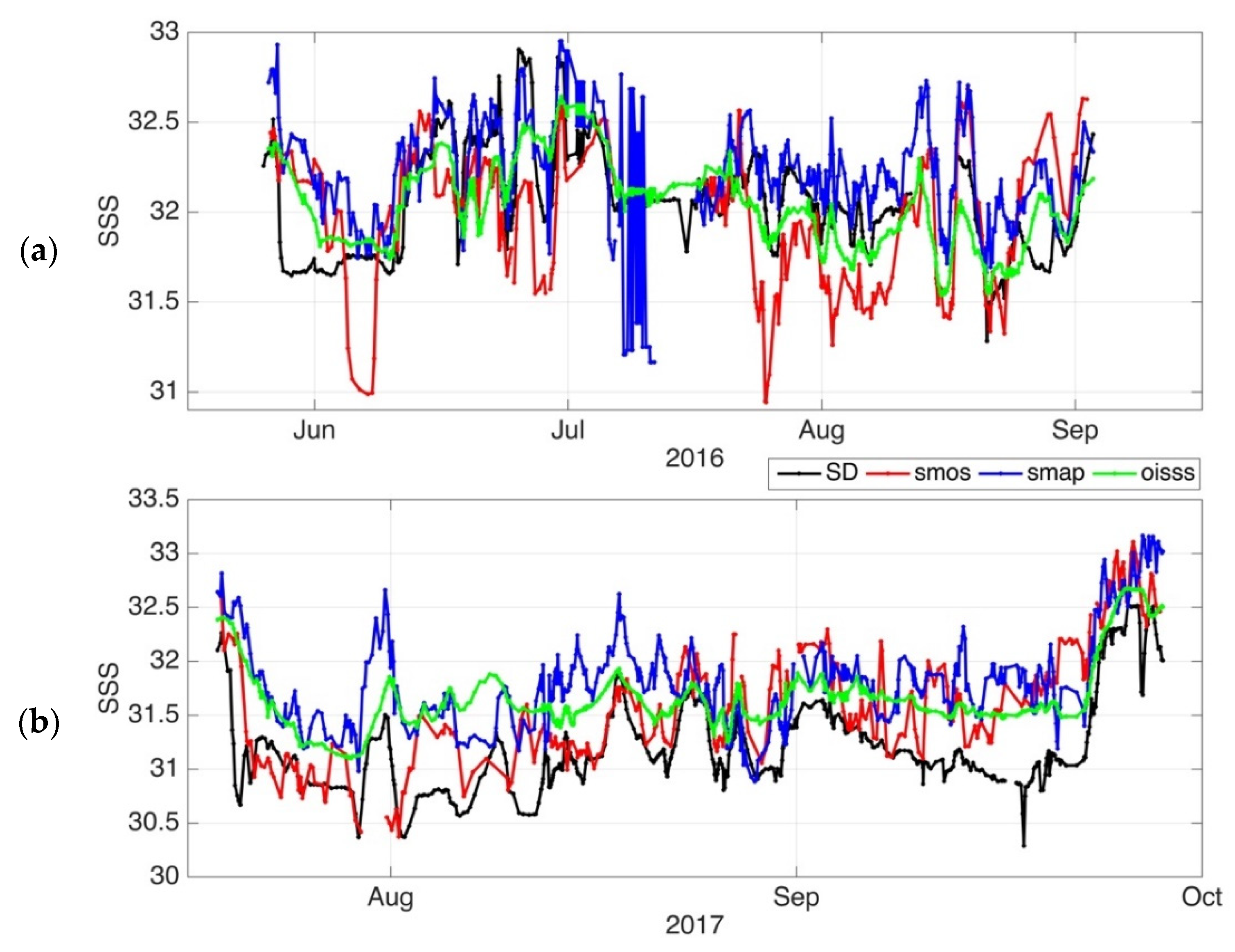
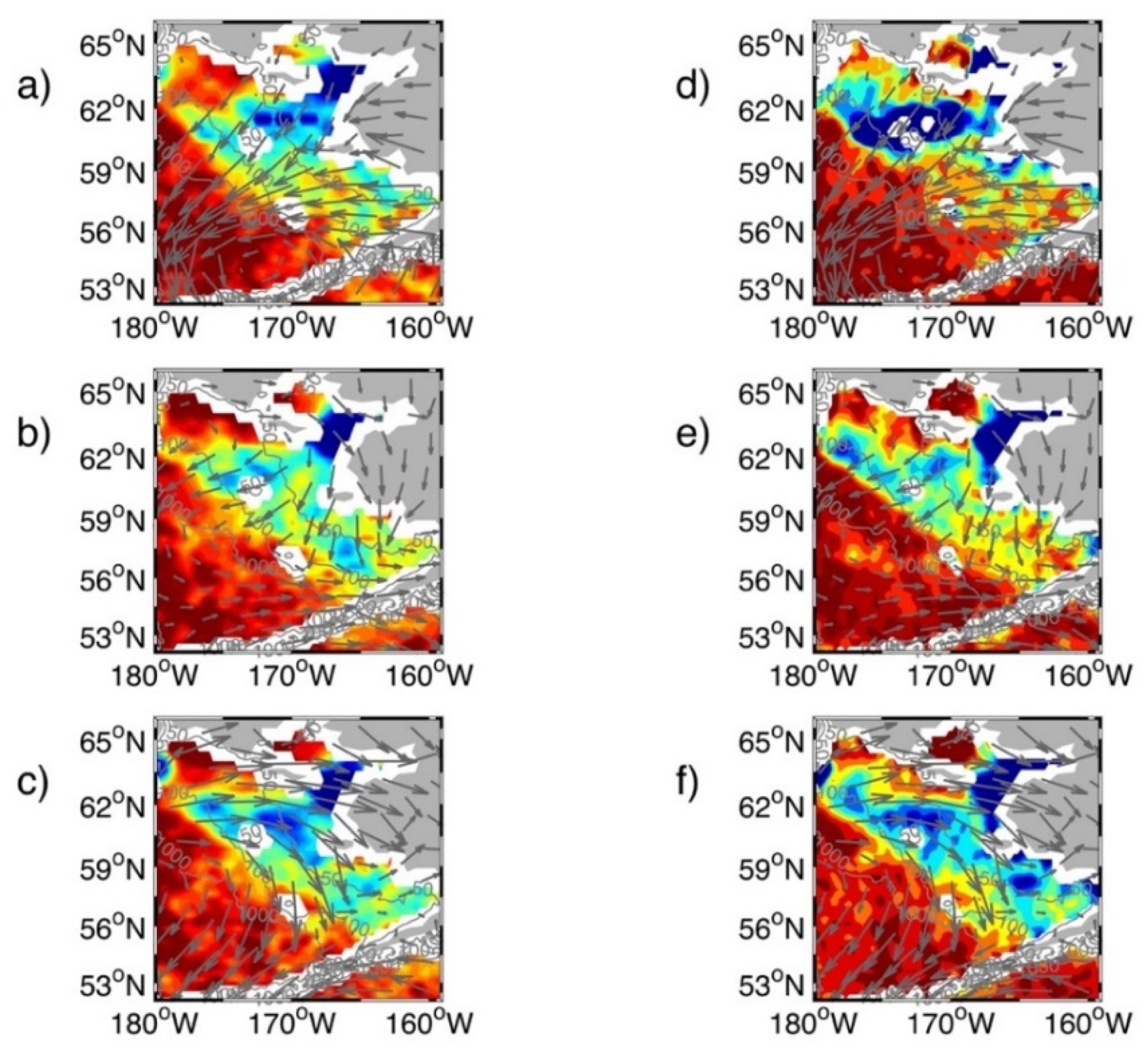
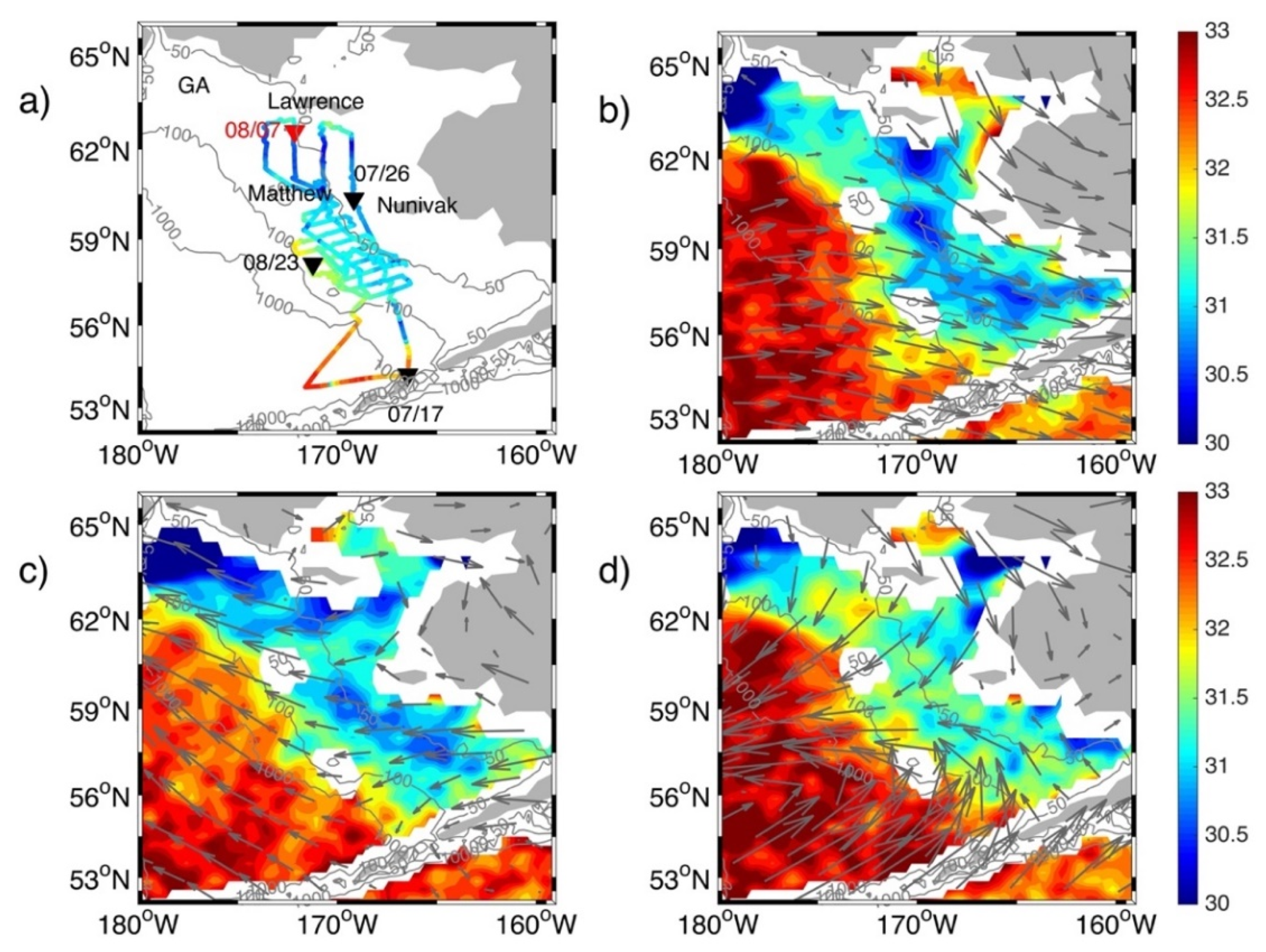
| SMOS | SMAP | OISSS | |||||||
|---|---|---|---|---|---|---|---|---|---|
| Saildrone Missions | Correlation | Bias | RMSD | Correlation | Bias | RMSD | Correlation | Bias | RMSD |
| SD126 2015 | 0.68(0.42) | 0.78 | 2.2 | 0.86(0.49) | 0.67 | 1.35 | 0.68(0.52) | 0.93 | 2.08 |
| SD128 2015 | 0.82(0.57) | 0.58 | 1.87 | 0.86(0.57) | 0.80 | 1.34 | 0.80(0.56) | 1.03 | 2.15 |
| SD126 2016 | 0.35(0.43) | 0.05 | 0.31 | 0.48(0.46) | 0.24 | 0.27 | 0.48(0.52) | 0.06 | 0.22 |
| SD128 2016 | 0.45 (0.46) | 0.13 | 0.37 | 0.60(0.42) | 0.16 | 0.28 | 0.72(0.58) | 0.02 | 0.20 |
| SD1001 2017 | 0.75 (0.51) | 0.39 | 0.36 | 0.73(0.53) | 0.61 | 0.32 | 0.83(0.60) | 0.45 | 0.24 |
| SD1002 2017 | 0.76 (0.53) | 0.56 | 0.64 | 0.85(0.64) | 0.79 | 0.54 | 0.87(0.62) | 0.52 | 0.46 |
| SD1003 2017 | 0.72 (0.55) | 0.62 | 0.63 | 0.82(0.62) | 0.79 | 0.53 | 0.81(0.63) | 0.63 | 0.52 |
Publisher’s Note: MDPI stays neutral with regard to jurisdictional claims in published maps and institutional affiliations. |
© 2022 by the authors. Licensee MDPI, Basel, Switzerland. This article is an open access article distributed under the terms and conditions of the Creative Commons Attribution (CC BY) license (https://creativecommons.org/licenses/by/4.0/).
Share and Cite
Zhao, J.; Wang, Y.; Liu, W.; Bi, H.; Cokelet, E.D.; Mordy, C.W.; Lawrence-Slavas, N.; Meinig, C. Sea Surface Salinity Variability in the Bering Sea in 2015–2020. Remote Sens. 2022, 14, 758. https://doi.org/10.3390/rs14030758
Zhao J, Wang Y, Liu W, Bi H, Cokelet ED, Mordy CW, Lawrence-Slavas N, Meinig C. Sea Surface Salinity Variability in the Bering Sea in 2015–2020. Remote Sensing. 2022; 14(3):758. https://doi.org/10.3390/rs14030758
Chicago/Turabian StyleZhao, Jian, Yan Wang, Wenjing Liu, Hongsheng Bi, Edward D. Cokelet, Calvin W. Mordy, Noah Lawrence-Slavas, and Christian Meinig. 2022. "Sea Surface Salinity Variability in the Bering Sea in 2015–2020" Remote Sensing 14, no. 3: 758. https://doi.org/10.3390/rs14030758
APA StyleZhao, J., Wang, Y., Liu, W., Bi, H., Cokelet, E. D., Mordy, C. W., Lawrence-Slavas, N., & Meinig, C. (2022). Sea Surface Salinity Variability in the Bering Sea in 2015–2020. Remote Sensing, 14(3), 758. https://doi.org/10.3390/rs14030758






